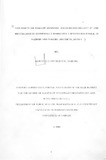| dc.description.abstract | This study investigated the bacteriological quality (total viable counts and coliform
counts) and assessed the risk of milk-borne zoonotic E.coli OJ57:H7 and brucellosis
infections in humans that may result from consumption of non -heat treated milk. Ways to minimize the risks from these hazards were evaluated and recommendations made.
The study was carried out by questionnaire and laboratory analysis of milk samples
obtained from consumer households in Nairobi and Nakuru district s as part of a large
study to assess potential milk-borne health risks that may be present in various
unpasteurised milk market pathways in Kenya. Between January 1999 and January 2000, survey data and raw milk samples were collected seasonally from households purchasing unpasteurised milk in urban and rural locations. Respondents were randomly selected within production system (extensive and intensive) and human population density (urban, peri-urban and rural) strata. A total of 264 samples were analysed in the laboratory. The samples comprised those from two seasons in Nairobi and one season in Nakuru District. During first seasonal survey in Nairobi (dry season), 49 households were sampled, while during the following wet season, 53 households were sampled. In Nakuru District, a total of 162 households (58 households from Nakuru urban area and 104 households from Nakuru rural) were sampled in the dry season. The Standard Plate Count (SPC) and Violet Red Bile Agar (VRBA) methods were used to enumerate the total viable and coliform counts and national standards applied to classify quality of the milk. Characterisation of the coliforms was further investigated based on the indole, methyl red, Voges Proskauer and Citrate (IMViC) reaction pattern. Identi fication of the E. coli 015 7:H7 was by streaking Escherichia coli cultures onto Biosynth selective indicator medium (BCM ™O157: H7 (+)(Biosynth International Inc., 1997) and serotyping using the latex agglutination test. Production of Verocytotoxin I and 2 was determined using reverse passive latex agglutination test (VTEC-RPLA). All the three samples that were positive on BCM™O157: H7 (+) medium were screened for genes encoding for virulence on Polymerase Chain Reaction (PCR). All the 264 samples were also screened for brucella antibodies using Milk Ring Test (MRT) and a more accurate Indirect Milk ELISA.
According to Kenya Bureau of Standards (KEBS), 83.7% of the milk samples collected
from Nairobi were of "bad quality" based on the threshold of 2 million c.f.u/ml for total
bacterial counts, while only 50% of the same samples were classified as such based on
the standard of 50,000 c.f.u/ml for coliform counts. Urban milk samples were of worse
bacterial quality than rural samples. Nakuru urban had 81% milk samples classified as
"bad quality" based on total counts (>2 million c.f.u/rnl), and 60% classified as such
based on coliform counts (>50,000 c.f.u/rn l). In contrast, only 40% of samples from
Nakuru rural were classified as "bad milk" based on both total and coliform counts.
Escherichia coli was recovered from 34% (91 out of the 264) of the samples analysed,
majority (63%) of which were of faecal origin. Of the 264 samples, two yielded
confirmed E.coli 0157:H7 isolates, one from Nakuru rural and the other one from Nakuru
urban. One of these isolates produced verocytotoxin I and this isolate was confirmed on
peR to be carrying genes for verocytotoxin production.
Six percent of the samples (16 out of 264) were positive for Brucella abortus antibodies
on MRT. Four of the positive samples were from Nairobi (dry season) while Nakuru rural
and urban had six positive samples each. ELISA detected more samples (21 ou t of 264 or 7.9%) as positive for brucella antibodies. These two tests for brucella antibodies had
moderate agreement (Kappa =0.40, 95% confidence interval=0.19 -0.60). The presence of brucella antibodies is an indication of possible presence of brucella organisms in milk, which may pose a risk to consumers. Those at high risk are consumers of traditionally fermented milk "maziwa lala", who constituted 6% of the households in Nakuru rural.
The health risk of zoonotic E. coli and brucellosis was considered to be minimal due to
the common consumer practice of boiling milk (commonly taken in tea). In this study.
over 96% of the households reported boiling milk prior to consumption. It is
recommended that in the absence of pasteurisation, the practice of boiling raw milk by
consumers be reinforced. | en |

